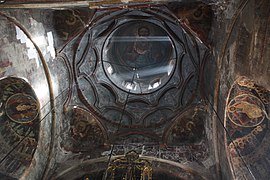Moldavian vault

The Moldavian vault[1] (Romanian: bolta moldovenească) is an architectural element of religious architecture used from the 15th to the 17th century in Moldavia.[2][3] It is an arched suspension system on pendentives.[4] It was mostly located above the naos or the main nave of the temple. The vault creates a transition from a square plane to a circular plane leading to a dome or tholobate tower. Consists of four diagonal arches over which pendentives transform square the circle. Four smaller segment arches in turn transform the circle into a square. Gradually they rise above the nave and crown the dome or tholobate tower.[5] The vault allows a significant reduction in the diameter and weight of the tholobate, the dome and the tower itself.[2][4][6][7][8]
History

In
The Moldavian vault is based on a folded dome on pendentives used in Byzantine architecture. The arched suspension system on the pendentives creates a transition from a square plane to a circular plane leading to a dome or tholobate tower. The transformation of the Byzantine vault system to the Moldavian one resulted in the expansion of the interior space and a reduction in the diameter or weight of the tholobate tower.
According to some experts, the Moldavian vault has its origins in
From the end of the 14th century, there were construction experiments in Moldavia that have lightened the weight from a tower with a small diameter. The columns were replaced by a corbel. This innovative solution first appears in the Old Church of the Moldovița Monastery. The technical solutions were probably optimized at the beginning of the 15th century. The Moldavian vault first appears during the reign of the Moldavian prince Stephen the Great in the Exaltation of the Holy Cross Church in Pătrăuți from 1487.[11]
The reduction of the diameter of the tower was used to cover the space of the so-called blind
In the 16th century, a newer variant was framed by arches. Sometimes it also appears in the form of overhanging ribs of the dome vault, which reduce the diameter of the dome itself. Such a solution can be seen, for example, in the
Gallery
-
Cross section and floor plan of the Church of St. Nicholas in the Bogdana Monastery. 14th century, Rădăuți, Romania
-
The interior Church of the Assumption of Virgin Mary in thePutna monastery, view of the Moldavian vault, 15th century, Putna, Suceava, Romania
-
The interior Church of St. Nicholas in the Probota Monastery, view of the Moldavian vault, 16th century, Probota, Romania
-
The interior Church in the Galata Monastery, view of the Moldavian vault, 16th century, Iași, Romania
-
The interior of the Church of the Ascension in the Golia Monastery, view of the Moldavian vault, 17th century, Iași, Romania
-
The interior of the Timișoara Orthodox Cathedral, view of the Moldavian vault, 20th century, Timișoara, Romania
See also
References
- ISBN 978-960-524-317-3.
- ^ a b Bonifaciu, Sebastian (1985). Romania, Tourist Guide. Editura Sport-Turism. pp. 46, 53, 333.
- ISBN 9780853346838.
- ^ ISBN 9789004421370.
- ISBN 978-3-89794-459-6.
- ^ a b boltă In: Drăguț, Vasile (1976). Dicționar enciclopedic de artă medievală românească. Bucharest: Editura Științifică și Enciclopedică. pp. 60–63.
- ^ Bolta moldovenesca In: "www.roarhitect.ro" (in Romanian). Retrieved 2021-07-01.
- ^ bolta moldoveneasca In: "Dicţionar de arta" (in Romanian). Retrieved 2021-07-01.
- ISSN 1857-0461. Retrieved 2021-07-11.
- hdl:11250/2622309. Retrieved 2021-07-11.
- ^ a b c Nesterov, pp. 111–113
- ^ Nesterov, pp. 114–118
- ^ mołdawskie sklepienie In: "Encyklopedia PWN" (in Polish). 2021-07-25.
- ISBN 978-1-4387-7538-8.
- ^ "Arhitectura din Moldova in secolele XIV-XIX" (in Romanian). 2021-07-25.
- ^ "Stilul moldovenesc" (in Romanian). 2021-07-25.
Further reading
- Kocój, Ewa (2006). Świątynie, postacie, ikony: Malowane cerkwie i monastyry Bukowiny Południowej w wyobrażeniach rumuńskich. Kraków: Wydawnictwo Uniwersytetu Jagiellońskiego. p. 41. ISBN 9788323385783.
- "The Painted Churches in Romania - Matchless Gems of Universal Art". Romania. Vol. 22 (International marketing information series ed.). United States. Embassy (Romania), United States. International Trade Administration. 1971. p. 18.
- Rumanian Art Treasures: Fifteenth to Eighteenth Centuries. Edinburgh: Royal Scottish Museum. 1966. p. 11.
- Christian Art in Romania: The 15th century (Christian Art in Romania ed.). Bucharest: Bible and Mission Institute of the Romanian Orthodox Church. 1985. pp. 24, 29.
- Hannover, Birgitta Gabriela (2007). Rumänien entdecken: Kunstschätze und Naturschönheiten. Berlin: Trescher Verlag. p. 325. ISBN 9783897941045.






